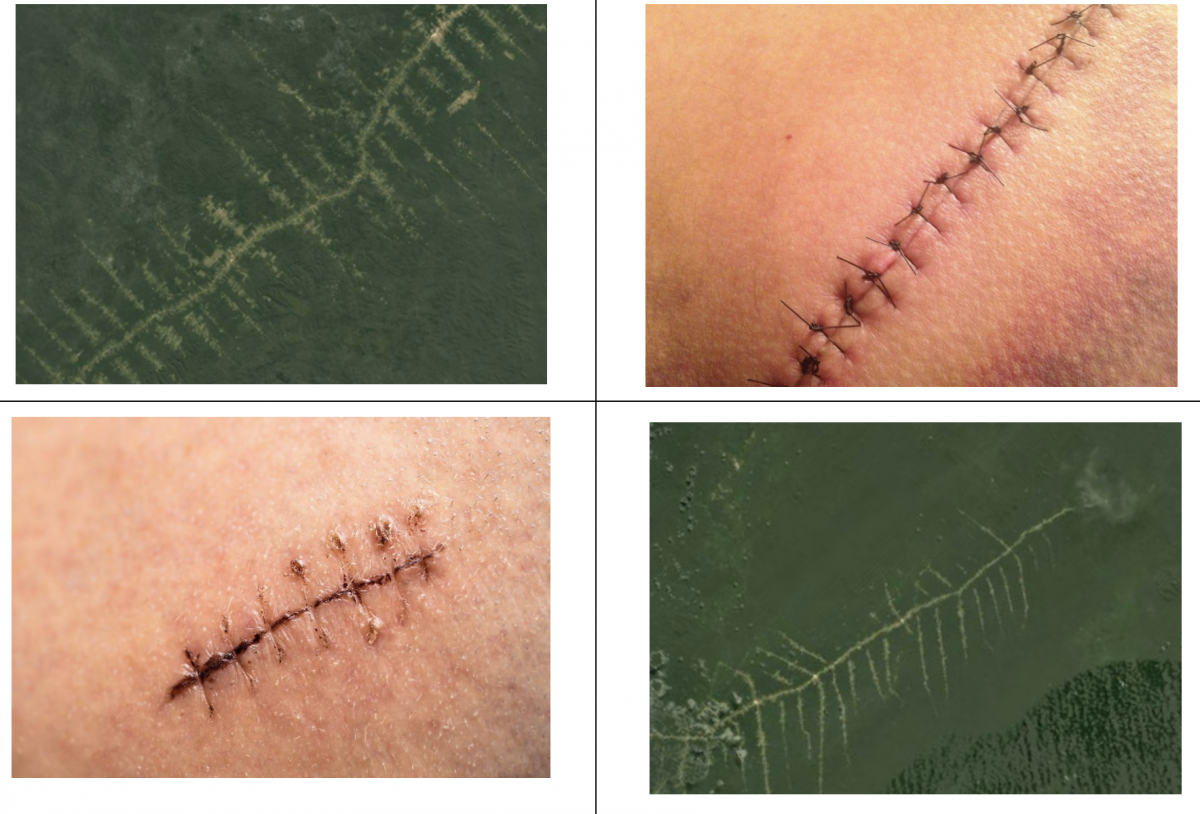Surface and Streak: Anatomies of Deforestation
Bruno Caldas compares the deforestation of the Amazon to human scars and wounds.
Bruno Caldas

We could define a drawing as the disturbance of a surface that results in a visual effect. Artists can choose a variety of surfaces to work on – paper, canvas, walls – that will be touched by a layer of paint or other materials. A patch of skin can be streaked by a needle under the dermis, where the ink deposited will remain until the death of the bearer of the tattoo. Skin can also be disrupted by other mechanical means, exposing the subcutaneous tissue to cause bleeding. This will leave the permanent skin feature known as a scar. The visual effect of the scar is often amplified by the perpendicular stitches made across it in order to suture the wound and support its healing.
When a road is opened through the surface of the jungle, it leaves a streak that is easily recognizable on satellite images. This mark is also known in scientific literature as scar. They can be produced also as a consequence of fire or logging, [1] which affect large continuous areas. Fire scars leave a dark texture which denotes the charred surface of where it used to be trees. Logging scars will leave a paler shade of green, clearly distinguishable from the canopies which were cut down. Road scars, on the other hand, are linear.
Highways are opened in the jungle to ease access to remote places, providing health support, transportation and trade opportunities. But most often, they are built on grounds of the colonization of these areas. In the 1970’s, the Brazilian military dictatorship defined the Amazon as a frontier to be occupied. In general, this settlement meant razing trees to create farms dedicated to industrial monocultures (such as soybeans) or cattle. To facilitate this, a gigantic road of 4000 kilometers would have to be built, known as Transamazon highway. It would cross the country from east to west, from the drought-plagued states in the northeastern region to the Colombian border. The task started in 1972 and was enormous: unstable soil and torrential rains made the construction daunting. Fifty years later, only a few stretches were finished and fewer are still usable. These stretches, however, had a very damaging impact as they were used to settle farmers that remove originary peoples and extract the rainforest’s logged wood. [2] In recent years, other road projects have been unfortunately more successful, allowing access from the southern limits of the Amazon.
When these roads are opened, they will immediately attract settlers to its path. In the semi-legal occupation methods of the Brazilian rainforest, the first thing needed is physical access to land. Legalization is likely to come later and might be obtained by fraud (grilagem) [3] or even official settlement programs. It is the roads that define the impulse for colonization and consequent deforestation. Their edges are occupied first, with the original vegetation removed to allow for farming or grazing. When they’re completely taken, exploration begins in perpendicular-oriented paths. This leads to a kind of devastation that is known as fishbone deforestation. [4] Smaller, self-funded accesses are opened and gradually enlarged, which lead the furthest possible from the original highway opened by the state. Then the edges of these smaller ones also get occupied, forming the shape that can be easily recognized through satellite imagery. [5] Ecological literature also catalogs other deforestation patterns such as radial or dendrite. [6]
But where scientists find an animal-related visual metaphor for deforestation, I see it as a completely human picture. To me these patterns resemble much more the shape which results from the dermatological trauma of scarring and stitching. Much as the open skin that immediately starts to heal, when the jungle is cut, it begins to regrow right away. Leaving the scar open is a struggle against nature which requires constant effort from the colonizers. This effort is only worthwhile because of specific economic conditions that make it so that, for the individuals squatting in and living off the Amazon, a standing tree has lesser value than a grazing ox. This set of economic conditions is also known as capitalism: externalities such as the vertiginous warming of the planet are not deduced from the price paid for raw meat or lumber from centenary trees, and are left to be paid by the whole set of inhabitants of the planet in the next centuries. The paintings created by disturbances on the surface of the Amazon are a living nightmare of wounds that never suture.
Notes
- https://doi.org/10.1016/j.jenvman.2021.112310
- https://doi.org/10.1016/j.foreco.2011.11.046
- https://outraspalavras.net/outrasmidias/amazonia-o-caos-fundiario-que-favorece-a-grilagem/
- https://www.proquest.com/openview/ef4e8990ecd17c741941c2f25052002d/
- http://www.servicemap.com.br/blog/desflorestamento-em-forma-de-espinha-de-peixe-na-amazonia/
- https://www.tandfonline.com/doi/pdf/10.1080/1747423X.2015.1027797
Ecological Thinking
This is the course blog for K-JI-11-23A – Ecological Thinking. In 2023-24, we explore “Vertical Ecologies” by visual arts, film and performance. The course is co-organized by Giovanna Esposito Yussif and Samir Bhowmik. Previously, in 2022-23, we organized a year-long collaborative research studio with Aarhus University, DK, Research Pavilion 2023 and Helsinki Biennial 2023 on the themes of environmental data, sensing and contamination.
Header image credit: Abelardo Gil-Fournier and Jussi Parikka / Seed, Image, Ground (2020)- With permission from the authors.
Latest posts
-
Ecocidal Development and Atmospheric Warfare - Guest Lecture by David Muñoz Alcántara, 18.3.
-
"Schizophrenic relationship with nature" - Guest Lecture by Matti Aikio, 12.2.
Follow blog